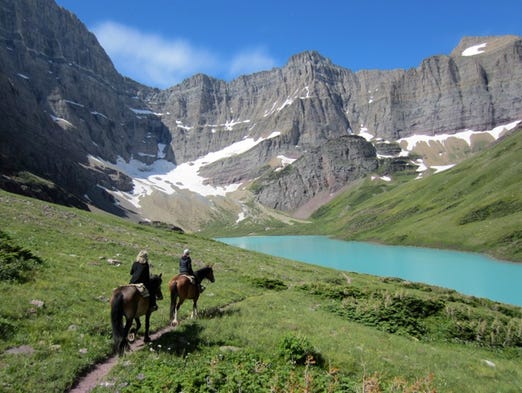Glacier National Park still has glaciers


There’s good news and bad news regarding the future of Glacier National Park.

The good news, if you can call it that, is that these
large-scale changes are still at least a decade away, and the park has
plenty of grandeur to go around until then.
History: Glacier Park Lodge, Lake McDonald Lodge, Many
Glacier Hotel and some of the park’s iconic chalets all were built by
the Great Northern Railway between 1910 and 1930. By encouraging tourism
in towns along its tracks, the railway played a critical role in
developing the American West.


Lauren Newman Alley, a spokesperson for the park, said the wildlife often surprises visitors the most.
“Imagine
driving up at sunrise and seeing a herd of bighorn sheep, or a bear
walking along a lakeshore in Many Glacier in the evening as you end your
day,” she said. “The wildlife makes everything even more amazing.”
In
addition to wildlife-watching, the park’s most popular diversion is
driving the Going-to-the-Sun Road, a 50-mile ribbon of concrete that
winds and switchbacks its way past waterfalls, up and over the
Continental Divide. Along the way this journey crests the Rockies at
Logan Pass, the park’s tallest point at 6,646 feet.

From the top, with views that seem to stretch forever,
it’s easy to understand why the park is considered the “Crown of the
Continent.” Technically, this moniker refers to the fact that these very
peaks are the headwaters for streams that flow to the Pacific Ocean,
the Gulf of Mexico and Hudson Bay. Metaphorically, however, it also
could refer to the fact that the panoramic vistas are unmatched anywhere
in North America.
Save for the park’s great
lodges, which were built by the Great Northern Railway, these views have
remained virtually unchanged since the park was created in 1910.

What has changed over time, as visitation has skyrocketed, is the way visitors experience the place.
Jason St. Clair has devised a strategy that works like
a charm. A transplant to Flathead Valley from North Carolina, St. Clair
says he’s visited the park dozens of times since he arrived in the
region in 2013. His approach: getting lost.

“There
are quite a few epic, very difficult hikes where there’s no trail or
markers and you have to be able to read a topo map and choose routes up
and over mountains and glaciers,” said St. Clair, who runs the horse
program at Averill’s Flathead Lake Lodge in Bigfork. “The park can get
really busy on marked trails, but once you push beyond it opens up and
becomes yours.”

About the park
Size: 1,012,837 acres.
Visitors: 2,946,681 in 2016.
Established: 1910.

Note: Goat Haunt, one of the most remote ranger
stations in the park, is just south of the border with Canada, which is
marked with a swath of cut trees.



Comments
Post a Comment